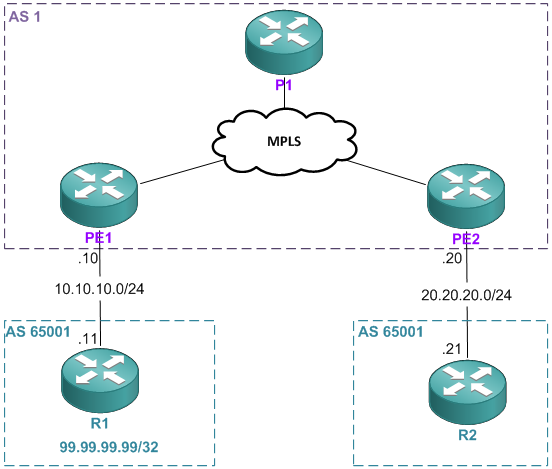BGP as-override and allowas-in:
Today i will discuss basic difference between as-override and allowas-in command & which are configure which router. [boxads]
These two functions are pretty similar, just with subtle differences. They can be used in an environment where a customer is using one AS number for many sites that are connected to an ISP. This is shown in the example below.

You can see that AS 65001 connects to the ISP at two locations. So when R2 receives the prefix 99.99.99.99/32, he will see that the AS path is via 1, 65001. Because of the loop prevention mechanism, R2 will have to reject this prefix because it can see its own AS in the AS_PATH attribute. I’ll demonstrate that now. But first, I’m going to post the full configurations because this can be pretty confusing to configure.
Total configuration:
PE1# ip vrf google rd 100:1 route-target export 100:1 route-target import 100:1 ! interface Loopback0 ip address 1.1.1.1 255.255.255.255 ! interface FastEthernet0/0 ip vrf forwarding google ip address 10.10.10.10 255.255.255.0 ! interface FastEthernet0/1 ip address 15.15.15.1 255.255.255.0 mpls ip ! router ospf 1 network 1.1.1.1 0.0.0.0 area 0 network 15.15.15.0 0.0.0.255 area 0 ! router bgp 1 no synchronization bgp log-neighbor-changes neighbor 2.2.2.2 remote-as 1 neighbor 2.2.2.2 update-source Loopback0 neighbor 2.2.2.2 next-hop-self no auto-summary ! address-family vpnv4 neighbor 2.2.2.2 activate neighbor 2.2.2.2 send-community extended exit-address-family ! address-family ipv4 vrf google neighbor 10.10.10.11 remote-as 65001 neighbor 10.10.10.11 activate no synchronization exit-address-family PE2# ip vrf google rd 100:1 route-target export 100:1 route-target import 100:1 ! interface Loopback0 ip address 2.2.2.2 255.255.255.255 ! interface FastEthernet0/0 ip vrf forwarding google ip address 20.20.20.20 255.255.255.0 ! interface FastEthernet0/1 ip address 25.25.25.2 255.255.255.0 mpls ip ! router ospf 1 network 2.2.2.2 0.0.0.0 area 0 network 25.25.25.0 0.0.0.255 area 0 ! router bgp 1 no synchronization bgp log-neighbor-changes neighbor 1.1.1.1 remote-as 1 neighbor 1.1.1.1 update-source Loopback0 neighbor 1.1.1.1 next-hop-self no auto-summary ! address-family vpnv4 neighbor 1.1.1.1 activate neighbor 1.1.1.1 send-community extended exit-address-family ! address-family ipv4 vrf google neighbor 20.20.20.21 remote-as 65001 neighbor 20.20.20.21 activate no synchronization exit-address-family [adsense]
R1# interface Loopback0 ip address 99.99.99.99 255.255.255.255 ! interface FastEthernet0/0 ip address 10.10.10.11 255.255.255.0 ! router bgp 65001 no synchronization bgp log-neighbor-changes network 10.10.10.0 mask 255.255.255.0 network 99.99.99.99 mask 255.255.255.255 neighbor 10.10.10.10 remote-as 1 no auto-summary
R2# interface FastEthernet0/0 ip address 20.20.20.21 255.255.255.0 ! router bgp 65001 no synchronization bgp log-neighbor-changes network 20.20.20.0 mask 255.255.255.0 neighbor 20.20.20.20 remote-as 1 no auto-summary
P1# interface FastEthernet0/0 ip address 15.15.15.2 255.255.255.0 mpls ip ! interface FastEthernet0/1 ip address 25.25.25.1 255.255.255.0 mpls ip ! router ospf 1 network 15.15.15.0 0.0.0.255 area 0 network 25.25.25.0 0.0.0.255 area 0 network 35.35.35.0 0.0.0.255 area 0
So currently, on R2, he is not accepting any prefixes from R1 in the other site; as shown below (we would expect the 10.10.10.0/24 and 99.99.99.99/32 networks to be in the BGP table).
R2#sh ip bgp | b Network Network Next Hop Metric LocPrf Weight Path *> 20.20.20.0/24 0.0.0.0 0 32768 i
The debug below shows why he’s not accepting these prefixes.
BGP as-override and allowas-in configuration:
One way to fix this is to use the allow-as-in command. This allows R2 to override the loop prevention mechanism by allowing an instance of AS 65001 to be in the AS_PATH. Let’s do that now.

So you can see (on R2) that the AS_PATH is 1, 65001 for these prefixes. It keeps all the AS_PATH information and simply just allows 1 occurrence of 65001 to be in the AS_PATH; thus overriding the loop prevention mechanism. We would obviously need to do this on R1 in order for R1 to have reach ability to the 20.20.20.0/24 prefix (sitting between PE2 and R2) so that he can have a route back to R2.
R1(config)#router bgp 65001 R1(config-router)#neighbor 10.10.10.10 allowas-in 1
R2#ping 99.99.99.99 Type escape sequence to abort. Sending 5, 100-byte ICMP Echos to 99.99.99.99, timeout is 2 seconds: !!!!! Success rate is 100 percent (5/5), round-trip min/avg/max = 68/83/116 ms
[bodyads]
The other way you can complete this task is by getting PE1 & PE2 to just strip AS 65001 from the BGP UPDATE before sending it to the customer edge routers. Let’s do that now.
R1(config-router)#no neighbor 10.10.10.10 allowas-in 1 R2(config-router)#no neighbor 20.20.20.20 allowas-in 1 pe2(config)#router bgp 1 pe2(config-router)#address-family ipv4 unicast vrf google pe2(config-router-af)#neighbor 20.20.20.21 as-override pe1(config)#router bgp 1 pe1(config-router)#address-family ipv4 unicast vrf google pe1(config-router-af)#neighbor 10.10.10.11 as-override
By configuring this command it actually resets the peer, so there’s no need to clear any neighbors. The result of this is shown on R2 below.
R2#sh ip bgp | b Network Network Next Hop Metric LocPrf Weight Path *> 10.10.10.0/24 20.20.20.20 0 1 1 i *> 20.20.20.0/24 0.0.0.0 0 32768 i *> 99.99.99.99/32 20.20.20.20 0 1 1 i
So the AS_PATH has been overridden by the PE routers to their AS number instead. This is the key difference between the two commands. Allowas-in allowed the loop prevention to be ignored for the configured amount of instances, and the as-override caused the PE routers to modify the AS_PATH.


